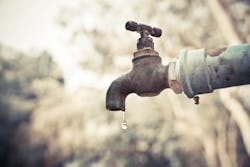Process and store more data faster — and educate consumers about water conservation
Water utilities around the world must prepare for a stark reality: as the world’s population increases and the climate continues to change, fresh water will become an ever-more-precious resource. The World Resources Institute’s (WRI) Aqueduct Water Risk Atlas finds that 17 countries — home to a quarter of the world’s population — face “extremely high water stress.” In these countries, agriculture, industry, and municipalities are, or will be, consuming up to 80 percent of available surface and groundwater in an average year.
Clearly, this is unsustainable. So what can be done to help reverse this trend? Water utilities should respond in two ways: repair or replace aging infrastructure to reduce loss and waste; and educate consumers about water consumption so they can take a more proactive role in conservation efforts. Pair these efforts with great execution, and both private and public water companies have an opportunity to lead conservation efforts while simultaneously running more efficient operations. The good news is that new digital technologies enable companies to do both efficiently. The bad news is not enough companies yet see the value and urgency in making a digital transformation.
Current State of Affairs
When water utilities plan for the future, they usually start with infrastructure. Utilities routinely deal with water loss due to leaky pipes, inefficient treatment facilities, and ruptured main lines. In fact, it’s no surprise that in the 2019 AWWA State of the Water Industry report, respondents listed “renewal and replacement of aging water and wastewater infrastructure” (and financing those improvements) as their top two concerns. In other words, if utilities were more efficient in extracting, treating, storing, and transporting water, it would have a major impact on the amount of water available for use.
Consumers are using more water than ever and who better to educate consumers on what that might mean for the future than their water utility? The average U.S. consumer’s water footprint, according to WaterAid.org, is twice the global average, and to equalize that with the rest of the world, U.S. consumers need to reduce their water footprint by 70 percent. Companies that take a leadership role in reducing wasteful consumption habits among U.S. consumers will not only help overcome a global humanitarian problem but also save customers money, enhance brand image, and improve service.
Some water companies are turning to digital technologies to help. Leveraging advanced metering infrastructure (AMI) along with smart leak detection devices, utilities can capture customer data in real time and aggregate it into a unified system to operationalize data and monetize insights. This approach gives valuable information to both customers and staff. Now, customers can easily see how their water usage affects their bill and their environment. Likewise, water companies have greater visibility into customers’ habits to improve how they plan, monitor, and manage their critical water infrastructure. Ultimately, they benefit from happier customers, reduced water waste, and greater efficiency.
Water May Be Scarce, But Technology Is Not
Smart water solutions — hardware, software, and data analytics to improve capital and operating efficiencies — are driving more than $35 billion of municipal spending over the next decade. At the root of this buildout are continued financial pressures on water suppliers and users to do more with less.
Digital technology in the water industry can mean a lot of things and has a lot of different nicknames, including “smart water,” “digital water,” and “Internet of Things” (IoT). New solutions hit the market in rapid succession, promising to optimize or improve specific or nuanced areas of focus. What’s been missing until recently is a platform that brings it all together and gets it to the customer.
For example, your CIS software probably does a good job of keeping track of your customers, locations, and bills. Your GIS software is great at mapping your infrastructure. Your SCADA system is optimizing your pumps and plants like never before. None of these systems likely talks to each other; and it’s rare that the real-time customer insights from these systems are made available to customers themselves. For instance, even if a utility uses advanced metering devices to detect a continuous or intermittent leak, it can only send a code back with the meter reading that the utility will see the next time the truck drives by. From a customer perspective, what good is finding out you have a leak after it’s already been going on for 20 days?
In fact, the idea of customer relationship management platforms to communicate to customers is relatively new to water utilities. One of the reasons for the lack of customer-facing systems in the water industry is the industry’s tradition of isolation. Essentially, water utilities have created such a reliable network of pipes and plants that most consumers don’t think about where their water comes from or where it goes. Water utilities, in kind, didn’t want to hear from their customers because that meant there was a problem.
Times have changed, as customer demand for improved service at lower cost, plus increased environmental awareness, are forcing a more personalized, communicative relationship between water suppliers and customers. Also, the broader trend of digitalization is changing the fundamental relationship between utilities and customers, morphing an isolated supplier into a connected service provider, and water is no exception. Fortunately, cloud-based customer relationship management platforms are available today to help water utilities become more customer-centric.
That’s the new job of the today’s water company.
Digital Transformation Is Now an Imperative
The technology to implement these types of transformations is already available to utilities, but few are making the move to implement them. Why?
Many companies are still using disk-based operating systems, early-generation systems like AS400 introduced in the late 1980s, and FoxPro-based CIS and AMR applications that reached their end-of-life years ago. Worse, companies have stacked newer applications on top of these legacy systems in an effort to get more out of them, but integration is difficult — like trying to teach an old dog new tricks. Even newer, on-premise applications, while specific to the water industry, are rigid and handicap a company’s ability to change to meet their customers’ demands.
For utilities today, it’s just as important to modernize technology as it is to replace leaking pipes. Companies must focus on eliminating data silos and start their digital transformation by aggregating the data that they already have. They must find cloud-based platforms that provide industry-specific functionality and start bringing data together in one picture. This software already exists. With it, a water company can better leverage its investment in smart technology and roll it up into one front-end, customer-facing application. It can finally deliver a customer experience that is rich with data but also clear and easy to understand. As important, utilities will have the data they need to plan smarter, move faster, and improve operations to save money and enhance service.
Here are four reasons why digital transformation is no longer a “nice-to-have” but an imperative for utilities.
Security. Cyber security is a real threat, and utilities are especially at risk. As utilities continue to store more sensitive data in outdated systems, customers are prone to identity theft. Worse, as utilities implement AMI systems with remote shutoff capabilities and internet-enabled SCADA systems, hackers could potentially shut down the flow of water for an entire community and contaminate water supplies that could result in illness and casualties. This has already happened multiple times in recent years, according to the American Water Works Association. In one water utility attack, cybercriminals exploited antiquated computer systems to gain access to valve and flow operations and were able to manipulate the water flow and amount of chemicals used to treat the water. Cybercriminals also accessed customer data via the company’s online payment system.
Artificial Intelligence. AI and machine-learning techniques are increasingly at the core of utilities’ ability to operationalize data and monetize insights. Companies that are using AI to “smarten” water systems include Pluto AI, EMAGIN, Fracta, and Fathom. Without a modern technology platform, these powerful AI applications are unavailable to water companies.
Conservation. Imagine giving customers access to all of the data available from all of your smart meters and IoT devices. Not only could customers log in and pay their bill, but they could see the total gallons used daily in their community, appliance efficiency, even a leak as it springs — in real time. This data becomes more valuable to your customers when they can recognize a correlation between the water level in their tub and in the nearby lake.
Efficiency. Water utilities are gathering more data than ever before, but without tying that data together and allowing your customers and staff to make actionable decisions, it is being lost. Use your data to better equip your customers and staff, to provide better customer service, to perform analysis, and to plan for the future.
Where to Go from Here?
As the world works toward SDG6, the burden to make significant progress will start at the largest water utilities with the greatest risks of water loss, but ultimately it will trickle down to consumers. Utilities should be laying the groundwork today so that water consumers are as engaged with their water source as they are with the local weather and traffic forecast. It’s up to utilities to point them in the right direction using the data that they already have and the technology they should be adopting. In doing so, and thus embracing a future that is paperless and automated, utilities will empower their customers to fully participate in the critical fight for water conservation. WW
About the Author
Nathan Gastineau
Nathan Gastineau is regional vice president with Vlocity Energy & Utilities.



